|
“Reconstructed Stone-Age circle in Germany catches sun’s rays”
December 22, 2005, M & C News, Scotland: “A reconstructed ‘temple of the sun’ in Germany caught the morning rays of the sun through its eastern gate early Wednesday, just as it is believed to have done after it was built by a lost culture 6,800 years ago.
|
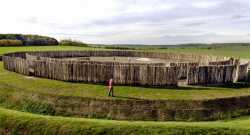
M & C News, Scotland
|
|
Archaeologists say the 75-metre-diameter Goseck Circle, on a flat river plain in eastern Germany, was built to help Stone-Age priests discern the solstice, the point in the year when the days begin to become longer and farmers look forward to spring planting.
|
The villagers of modern Goseck and visitors from all over Germany gathered at the site for its official opening, seven months after workmen began cutting 2,300 oak poles in a nearby forest and erecting them in two concentric circles at the site.
Goseck has been dubbed the German Stonehenge, though it is twice as old as the Stonehenge megalithic circle in southern England and has no stones. The original wood rotted away long ago, so new palisades, or wooden walls, were constructed in the same post-holes.”
[Full Story]
“Ancient Indian lunar observatory in Ohio town
is eclipsed by golf”
November 27, 2005, StarTribune, USA: “As more people rediscover the original purpose of the Newark Earthworks, an effort to watch the moonrise from the mounds is in conflict with the country club there now.
The Hopewell Indians used sharp sticks and clamshells here 2,000 years ago to sculpt 7 million cubic feet of dirt into a sprawling lunar observatory and the spiritual center of their far-flung empire.
Today it is an easy par 3 flanked by sand traps shaped like kidney beans. For generations, few in Newark thought it strange that golfers at the Moundbuilders Country Club whacked little white balls across ground once hallowed to an ancient community.
But now that the mounds have been rediscovered, in a way, there is an eagerness from many people to see moonrises from the mounds the way the Indians did. And this has caused a conflict with the golf club.”
[Full Story]
“African Astronomical History Symposium”
November 08/09, 2005, ASSA, South Africa: Programme & Selected Abstracts:
Astronomy and Stelae at Nabta Playa:
“Lying about 100 km west of Abu Simbel in southern Egypt, Nabta Playa is an internally drained basin, which was occupied by pastoralists in the period of 11,000- 5000 years ago. During that time, the hyper-aridity of the Western Desert was interrupted by the northward movement of the summer rains of tropical Africa. Beginning about 7500 years ago a regional ceremonial center was established containing cattle burials, complex stone structures, a calendar circle, and sandstone stelae. The presence of these massive stelae suggests a long-lived political authority and a ceremonialism involving both the sun and stars. Like Stonehenge, the stelae of Nabta Playa have generated both science and controversy.
The Sky’s things; /Xam Bushman cosmology:
“According to the /Xam, or Colonial Bushmen, who lived in what is now South Africa’s Northern Cape Province, the celestial bodies and their present composition, position and ‘behaviour’ originate in events that took place in a mythological time in which all living organisms and natural phenomena possessed, simultaneously, human characteristics as well as those nascent properties which would later come to define them as the entities we know today. This presentation chronicles various /Xam narratives in which the nature and origins of ‘the sky’s things’ are explained.
The Indigenous Astronomical Knowledge of the Xhosa:
“Xhosa people named many stars and star patterns in the night sky, and derived their calendar from heliacal risings and the cycle of the Moon. In particular, the reappearance of Isilimela (Pleiades) was used to set the date of initiation ceremonies. Planets were also observed. Much knowledge has already been lost but the author has attempted to recover as much as possible through field trips and radio broadcasts.”
[Symposium HomePage]
“Southeastern Colorado – Autumn Equinox archaeoastronomy”
September 18, 2005, Denver Post, USA: “Twice a year the National Forest Service folks who mind the Comanche National Grasslands southwest of Springfield open the gate on Crack Cave in Picture Canyon for a modern-day view of carvings plains Indians created maybe 700 years ago to mark the equinoxes.
‘It really is breathtaking,’ says Yvonne Taylor, who’ll lead a group to the cave before dawn Thursday morning. ‘You’re sitting there looking at it, and there’s a little light, and then BAM! It’s just brilliantly lit up.’
The notches are illuminated for 10 minutes and then fall back into the shadows until the next equinox, which comes on March 20. ‘We get there right before sunrise, so it’s still a little dark. You can just sit and imagine what it felt like to be in a wagon train or to be a plains Indian,’ she says. ‘It’s pretty humbling.’“
[Full Story]
“Ancient astronomers subject of talk”
September 14, 2005, AZ Daily Sun, USA: ” Archaeoastromer Bryan Bates will discuss historic and prehistoric use of signs in the sky during a free lecture today at Northern Arizona University.
For centuries, the ancestral Puebloan people of the Southwest have observed the movement of the sun, moon, and stars to determine the timing for such critical societal functions as planting, harvesting, and ceremonial gatherings. Bates will highlight how ancient people observed the changing sky and used information from these observations to improve the likelihood of survival for their people.
Bates is an interpretive naturalist and guide for numerous organizations including the Grand Canyon Field Institute, and is an avid Grand Canyon backpacker with 25 years of experience in the park’s backcountry. He served as the chairman of the 7th Oxford Conference on Archaeoastronomy in Flagstaff in 2004, sits on the council of the International Society for Archaeoastronomy and Astronomy in Culture, and is a member of the board for the Flagstaff Festival of Science.”
[Full Story]
“The history of rock: Ozarks resident says formation
served as ancient observatory”
September 06, 2005, The Joplin Globe, USA: “A Fordland man says he believes a paw-like formation, made of rocks and set in the thin soil of one of the Ozarks’ famous bald knobs, was a sophisticated observation point that was used to track stars and planets by people who lived in Southwest Missouri 1,500 years before the birth of Christ.
|
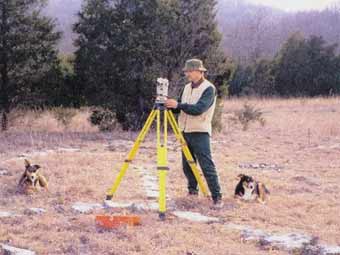
The Joplin Globe/Lyle Sparkman, USA
|
|
Doug Porter will be the guest speaker at a meeting Thursday of the Southwest Missouri Chapter of the Missouri Archaeological Society.
He will explain how he came to the conclusion that ancient people used points on the 50-foot-wide shape to spot the winter and summer solstices, the fall and spring equinoxes, and the rising and setting of the planet Venus, and to make other, more obscure astronomical observations.
|
‘This thing is probably one of a kind on the planet,’ Porter said. ‘I know of nothing similar that marks so many different astronomical points found anywhere in the whole world. I think it’s only a coincidence that it looks like a bear paw, but we can never know whether that is intentional or not.’
Porter, a builder by trade and an amateur archaeologist by hobby, spent three years studying the site he’s come to call the Venus Petraform while recovering from a back injury that left him unable to work. The formation, located in the Springfield area, also is called the Hawkins Site after its owner, Dolan Hawkins.
[Full Story]
“Oldest hieroglyphs discovered in Damaidi”
August 18, 2005, People’s Daily, China: “Another important discovery was made in the Damaidi cliff paintings which had once caught the attention of the world.
According to the examination by ancient writing experts China’s oldest hieroglyphs have been discovered among Damaidi cliff paintings.
The surveys and studies by cliff painting experts at Northwest No.2 University for Nationalities found 3,172 groups including over 8,400 individual cliff painting figures at Damaidi of Ningxia.
The figures feature celestial bodies, heaven, earth, gods, hunting and pasture, dancing and sacrifice etc. A dating method using Xanthoria elegans determined that the early cliff paintings were 18,000 to 10,000 years old.”
[Full Story]
“Aboriginal astronomers see mythology in stars”
August 16, 2005, ABC News Online, Australia: “Aboriginal bark paintings, stories and historical archives are helping an astrophysicist to learn more about Indigenous Australians’ long history of documenting stars in the southern sky.
Dr Ragbir Bhathal of the University of Western Sydney is delving into a wealth of astronomical information buried in archives at the National Library of Australia.
This includes written records of public servants, pastors, writers, scholars and explorers who spoke to local Aboriginal people and documented their stories as they travelled the strange new southern land.
He also plans to travel to Arnhem Land, in the Top End, to hear Aboriginal stories first-hand. Aboriginal Australians were the first to document stars in the southern hemisphere.
Some are still using the stars to guide hunting and food gathering, and as a source of moral instruction passed down through oral history.
In this way Aboriginal people combine a rich cosmic mythology with observational astronomy, Mr Bhatal says.”
[Full Story]
“Summer Solstice at Stonehenge”
August 07, 2005, Islam Online, Qatar: “Stonehenge is one of the most famous prehistoric monuments in the world. Built around 2,500 BCE, the site, like the Egyptian pyramids, is a testament to the engineering skills of our ancestors. Its circle of linteled sarsen stones were so finely erected that they still outshine the most intricate working of wood.
The inner stone trilithons are simultaneously majestic and intimate, and the whole site is laid out with extraordinary precision whilst remaining open to the natural contours and horizons of Salisbury Plain, on which it is located.
One of the key aspects of Stonehenge is that astronomical alignments have been deliberately and accurately built into the design of the monument itself.
|
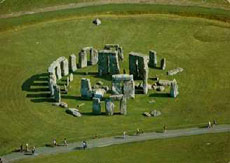
Islam Online, Qatar
|
|
One of these alignments is on the summer solstice sunrise. Watched from the center of the circle, the sun rises in the north east, just left of the Heel Stone (an important freestanding monolith on the edge of the monument).
|
On a clear day, as the sun rises in the sky, it shines down the avenue leading into Stonehenge and casts a shadow of the Heel Stone into the centre of the monument before rising to reach its highest point in the sky by noon.
The summer solstice is not the only alignment at Stonehenge, and debate continues about the range, accuracy and importance of the extent of complex astronomical knowledge built into the monument.
But whatever the finer technical points of these debates may be, the central fact is that the builders and users of Stonehenge were concerned, obsessed even, with astronomy and they knew the movements of the planets and heavens and their relationship with earth very well.
[Full Story]
“Ancient Aryan civilization achieved incredible technological progress 40 centuries ago”
July 16, 2005, Pravda, Russia: “President Putin has recently visited one of the most mysterious places on planet Earth – the ruins of the ancient town of Arkaim, which is situated on the outskirts of the city of Chelyabinsk.
Scientists discovered mysterious circles on the area of the ancient Russian town of Arkaim, which is the same age with Egypt and Babylon.
|
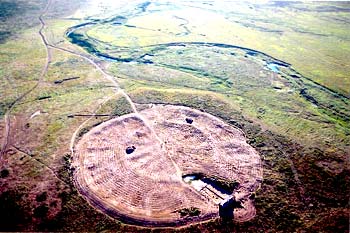
Pravda, Russia
|
|
The Arkaim valley in the south of Ural was supposed to be flooded in 1987: local authorities were going to create a water reservoir there to irrigate droughty fields. However, scientists found strange circles in the center of the valley:
The authorities gave archaeologists 12 months to explore the area.
|
Archaeological excavations showed that the people, who inhabited Arkaim, represented one of the most ancient Indo-European civilizations, particularly the branch, which is referred to as the Aryan culture.
Arkaim turned out to be not only a town, but also a temple and an astronomic observatory. Arkaim was built according to a previously projected plan as a single complicated complex, which also had an acute orientation on astronomic objects.
[Full Story]
“Archaeologists figure out mystery of Stonehenge bluestones”
June 24, 2005, The Western Mail, Cymru: “Archaeologists have solved one of the greatest mysteries of Stonehenge – the exact spot from where its huge stones were quarried. A team has pinpointed the precise place in Wales from where the bluestones were removed in about 2500 BC.
It found the small crag-edged enclosure at one of the highest points of the 1,008ft high Carn Menyn mountain in Pembrokeshire’s Preseli Hills.
The enclosure is just over one acre in size but, according to team leader Professor Tim Darvill, it provides a veritable ‘Aladdin’s Cave’ of made-to-measure pillars for aspiring circle builders.
Within and outside the enclosure are numerous prone pillar stones with clear signs of working. Some are fairly recent and a handful of drill holes attest to the technology used. Other blocks may have been wrenched from the ground or the crags in ancient times.
They were then moved 240 miles to the famous site at Salisbury Plain, Wiltshire.
The discovery comes a year after scientists proved that the remains of a ‘band of brothers’ found near Stonehenge were Welshmen who transported the stones. The skeletons were found by workmen laying a pipe on Boscombe Down and chemical analysis of their teeth revealed they were brought up in South West Wales.”
[Full Story]
“Sun sets on an ancient riddle”
June 22, 2005, Gulf Daily News, Bahrain: “Around 25 archaeologists and members of the public from Bahrain and Saudi Arabia gathered yesterday to witness sunset at the 4,000-year-old Saar settlement. They were invited along by Dammam Regional Museum archaeologist Nabiel Al Shaikh, who was hoping to prove his theory that the Dilmun civilisation celebrated New Year on June 21 – the first day of summer (the summer solstice).
Mr Al Shaikh claims an ancient temple at the settlement, which has an oddly positioned triangular corner room, was used as an astronomical device to measure the position of the sun.
He believes that during the summer solstice the sun would set over the corner of the temple – letting priests know that it was the beginning of the New Year.”
[Full Story]
“Thousands celebrate solstice at Stonehenge”
June 21, 2005, The Guardian, UK: “An estimated 21,000 people today gathered at Stonehenge to watch the sun rise above the ancient monument on the longest day of the year.
At 4.58am, the earliest time at which the sun makes the passage above that part of Salisbury Plain, cheers rang out as it rose over the monument’s ‘heel’ stone.
|
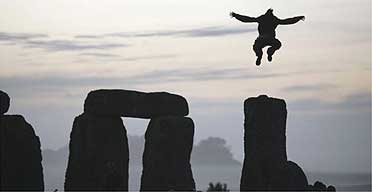
The Guardian, UK
|
|
A few high wisps of cloud, together with low-lying mist, added to the atmosphere of dawn on the longest day of the year.
The all-night festivities at the ancient stone circle, in Wiltshire, passed relatively peacefully.
|
Before dawn, King Arthur Pendragon, 51, the head battle chieftain of the British Council of Druids, led a troop of warriors – all anthropology students from the University of East London – in a dance honouring mother nature, whose effigy was held aloft and illuminated by fiery torches.
King Arthur said the summer solstice signified the mythical oak king, who rules the first half of the year, being beaten in battle by the holly king, the ruler of the second half of the year.
‘The solstice is about the death and regeneration of nature,’ the king, dressed in a white gown and wearing his sword, said. ‘Celebrating the summer solstice is part of our religion. We celebrate the shortest day, the longest day and the two equal days.’
[Full Story]
“Solstice celebrations at Hill of Tara”
June 21, 2005, RTE News, Ireland: “Celebrations to mark the summer solstice took place today at the Hill of Tara in Co Meath.
The celebrations climaxed this evening with a torch-lit procession. Druids from Ireland and further afield visited the ancient site to mark the longest day of the year.
The Save Tara/Skryne Valley Group, which opposes the planned route of the M3 motorway, asked visitors to pay a silent visit to the nearest archaeological excavation site to register their protest at the decision to allow this activity to begin.”
[Full Story]
“Stonehenge druids ‘mark wrong solstice'”
June 21, 2005, The Daily Telegraph, UK: “Modern-day druids, hippies and revellers who turn up at Stonehenge to celebrate the summer solstice may not be marking an ancient festival as they believe.
The latest archaeological findings add weight to growing evidence that our ancestors visited Stonehenge to celebrate the winter solstice.
Analysis of pigs’s teeth found at Durrington Walls, a ceremonial site of wooden post circles near Stonehenge on the River Avon, has shown that most pigs were less than a year old when slaughtered.
Dr Umburto Albarella, an animal bone expert at the University of Sheffield’s archaeology department, which is studying monuments around Stonehenge, said pigs in the Neolithic period were born in spring and were an early form of domestic pig that farrowed once a year.
The existence of large numbers of bones from pigs slaughtered in December or January supports the view that our Neolithic ancestors took part in a winter solstice festival.”
[Full Story]
“New cosmological insights from the East”
June 12, 2005, Sify News, India: “Eastern religious traditions can provide new cosmological insights as the methods used by ancient cosmologies for predicting solar and lunar eclipses yield results almost as accurate as our modern ones, and in the case of India, the Hindu pundits still use them, says Dr Paul Utukuru, a retired medical physicist in the Science and Theology News, a French monthly newspaper.
‘Some ancient astronomers seemed to have arrived at the conclusion that the creation of the universe, its growth, its eventual decay and regeneration are eternal processes without a beginning and without an end, repeating in endless cycles,’ he says.
The Hindus named each half cycle a night or day of Brahma in symbolic terms. There is also the mention of a transition or a twilight zone referred to as Yugasandhi between these half cycles.”
[Full Story]
“Rebuilding Germany’s Temple of the Sun”
June 04, 2005, Deutsche Welle, Germany: “A project to faithfully reconstruct a 7,000 year-old solar observatory, the oldest of its kind in Europe, began this week at Goseck in the German state of Saxony.
|
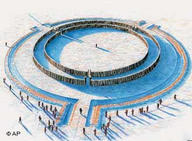
Deutsche Welle
|
|
The reconstruction, which is estimated to cost a total of 100,000 euros ($122,830) at its completion, should be finished by the end of the year and the restored observatory will join the growing list of increasingly popular “Sky Way” attractions of ancient sites related to the study of astronomy.
|
The observatory was first discovered in 1991 when the 75 meter diameter circular outer ring was unearthed by archeologists after an aerial photograph revealed the site.
[Full Story]
“Amateur to share petroglyph theories”
May 06, 2005, Duluth News Tribune, USA: “About 5,000 years ago, American Indians began chipping hundreds of figures and designs into exposed bedrock in southwestern Minnesota.
A Duluth man believes that many of these petroglyphs are more than examples of artistic expression. Chuck Bailey theorizes the site served as a celestial observatory and large calendar.
‘There’s no accident here,’ he said. ‘It’s very carefully planned, very carefully laid out; it had a specific purpose. I believe this is the local calendar site for southwest Minnesota.’“
[Full Story]
“Scientists study Serpent Mound for cosmic samples”
April 18, 2005, The Cincinnatti Post, USA: “Scientists studying recent rock samples taken from beneath an ancient earthen mound are trying to determine what caused unusually high concentrations of a metal rarely seen anywhere but near Earth’s molten core or in asteroids and comets.
Serpent Mound, an earthen snake effigy believed to have been built from about 1000 B.C. to A.D. 200 is in Adams County about 60 miles east of Cincinnati.
Some believe the 1,348-foot-long mound had a religious function for its builders, although nobody knows for sure what philosophy and beliefs shaped its origin because the mound builders left no written records.
Geologists only recently discovered high concentrations of iridium 1,412 feet beneath the mound. The levels of the silver-gray metal, occasionally brought up in lava from volcanoes, measured 10 times beyond what is usually present in the Earth’s crust.
Since there are no lava fields in Ohio, some geologists point to the iridium as evidence that the mound sits upon a slightly oblong crater created when a massive extraterrestrial object slammed into Earth.”
[Full Story]
“Planetary alignment caused tsunami, says a scientist”
April 16, 2005, Deccan Herald, India: “The deadly tsunami on 26 December, 2004 was the result of Saturn, Moon, Earth and the Sun falling in a straight line, claims a retired scientist of Department of Atomic Energy.
Paramahamsa Tewari, who supervised construction of Narora and Kaiga atomic plants and authored controversial ‘space vortex theory’, says his conclusion about the cause of tsunami stems from his theory that all spinning cosmic objects including the Sun develop electrical fields that repel each other.
On the fateful day, Saturn, Moon, Earth and the Sun were perfectly aligned. As a result, Earth was subjected to the repulsive electrical force of the Sun on one side.
But the balancing force on the other side due to Saturn was very much reduced as it was shielded by the Moon which does not spin and therefore has no electrical repulsive force on its own, he claims.”
[Full Story]
“Ancient African Skies”
April 07, 2005, Space.com, USA: “We had heard of an ancient astronomy site in this region made up of basalt pillars that were magnetic, so needed to be remeasured using something other than compasses.
The pillars were known as ‘Namoratunga’ or ‘stone people’ in the Turkana language. They had been said to have been built for an astronomical purpose, to reckon the Borana calendar, and were reputed to be a couple of thousand years old.
They had petroglyphs on them, some matching the ancient property symbols of the Kush, a people of the Sudan who had once conquered Egypt (in the 8th Century B.C.) and whose language has yet to be deciphered. From maps of ancient Kush, I knew that the front of almost all their pyramids appeared to face the star Sirius, which has not changed its position in the sky very much for the last several thousand years.
We had a description of the Borana calendar, but this did not make astronomical sense. For example, the new year of the Borana calendar was said to occur when the star beta Triangulum was ‘in conjunction’ with the new moon (new, give or take a couple of days).
A new moon is, of course, close to the sun (i.e., a thin crescent), and consequently found in the twilight sky. However, the star beta Triangulum is a 3rd magnitude star and could not been seen in twilight. Thus, we could not even get the Borana new year started according to the description we had from anthropologists.”
[Full Story]
“‘No Shadow at Luozhou’: The Meaning and Significance
of a Summer Solstice Event”
April 07, 2005, UCLA Asia Institute, USA: “Yijing (I-tsing)‘s Accounts of the Inner Law Sent Home from the South Sea (Nan-hai Ji-gui Nei-fa-zhuan) was a well-known work of the 7th Century that broadly described Buddhist disciplinary life in India and Southeast Asia during his time.
In the book, while talking about how to reckon time according to observing sundial, Yijing said that on the day of the Summer Solstice ‘in contrast to other places no shadow is cast at Luozhou’.
Luozhou, roughly speaking, is today’s Luoyang in China. It is located between the 34 and 35 degrees of the north latitude. From the astronomical point of view, at this latitude it is impossible that this happens at any time or in any season.
Is this a mistake in Yijing’s book or is there any other meaning behind it? It has become a question or riddle since the end of 19th century when J. Takakusu published his English translation of Yijing’s book. Takakusu explained that here ‘Luozhou’ means probably Central India.
Recently, Professor Wang discovered that in China at a place in Central China people can indeed see on the day of the Summer Solstice at an ancient observatory that there is ‘no shadow’ in the sun.”
[Full Story]
“Statue Hid Hipparchus Star Catalog”
April 02, 2005, Physics Today, USA: “Since Alexandria’s great library was ransacked 1600 years ago, astronomers have searched in vain for a copy of the Hipparchus star catalog, the earliest sky map known to have used a coordinate system.
|
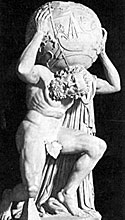
Physics Today
|
|
Now, an astrophysicist vacationing in Naples, Italy, believes he has found a copy sitting in plain view on a statue of Atlas, the Greek god sentenced to bear the weight of the heavens.
The two-meter-tall statue, called the Farnese Atlas, was unearthed in the 1400s and is in the National Archaeological Museum in Naples.
|
It is believed to be a second-century-AD Roman copy of an earlier Greek original.
For years historians had speculated that the globe on the giant’s shoulders, which is marked with 41 Greek constellations and with lines indicating the celestial equator, tropics, and ecliptic, contained an accurate sky map.
[Full Story]
“Scientists Study Anasazi Calender”
March 21, 2005, KSL5 TV News, USA: “Don Smith, College of Eastern Utah, San Juan branch: ‘I think we’re becoming more aware that those people were far more familiar with astronomy, science and possibly math than we give them credit for.’
In a secluded ravine near Blanding, scientists and researchers gather to watch mysterious images forming right before their eyes.
|
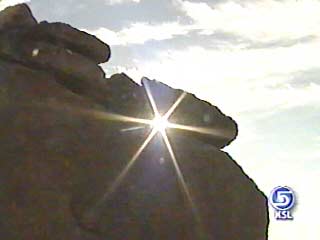
KSL5 TV News
|
|
Although the rite of Spring, at least on our calendar, slipped in here yesterday almost unnoticed, it’s literally in your face in this strange little canyon.
We arrived weeks before spring equinox because people studying this place can come here eight different times during the year to watch a series of events.
|
It’s a little hike to get down to this site, but once here, you can almost feel what it was like a thousand years ago
[Full Story]
“Visitors flocking to pyramids for equinox”
March 21, 2005, The Herald/El Universal, Mexico: ” Clear skies welcomed the arrival of the spring equinox on Sunday at the towering Pyramid of the Sun northeast of Mexico City, where the occasion has come to be celebrated with ritual dances, drumming and incense.
The vernal equinox the halfway point between winter and summer was arriving late Sunday afternoon at the pyramids of Teotihuacan, the sprawling Pre-Hispanic religious site 30 miles (50 kilometers) from the capital.
Workers at archaeological zones across Mexico braced for an onslaught of visitors on Monday, the first full day of spring.
It also is a popular day to visit Chichen Itza, the most famous of Mayan ruins on the Yucatan peninsula, and watch the a serpent-shaped shadow slither down the Temple of Kukulkan at daybreak.”
[Full Story]
“Exploring the Sun Through Ancient Civilizations”
March 18, 2005, ScienceBlog, USA: “What do Stonehenge, Mayan pyramids, and a spacecraft a million miles away have in common?
They’re linked by a human need to explore and understand the Sun, moon, planets, and stars. This year’s Sun-Earth Day on March 20 focuses on ‘Ancient Observatories: Timeless Knowledge’ and falls on the vernal equinox when day and night are the same length.
Appropriately, NASA and the Exploratorium in San Francisco are focusing on ancient peoples and their fascination with the Sun, which played a major role in most Native American religious practices and social events.
NASA continues to pay close attention to the Sun today through ground and satellite-based observatories, still seeking to understand this star as a dominant influence on our lives. The Sun seems to have a major role not only in religious practices of indigenous people, but also art, culture, and more.”
[Full Story]
“Ancient knife proves longer astronomical history”
March 12, 2005, XinhuaNet, China: “Archaeologists in northwest China’s Qinghai province claimed that a 5,000-year-old stone knife with designs of constellations will extend China’s history of astronomical observation by 1,000 years.
|

XinhuaNet, China
|
|
The finely-polished stone knife, six centimeters long and threecentimeters wide, was unearthed at the Laomao Ruins, a New Stone Age site nine kilometers west of Lamao Village in Qinghai.
Archaeologists also unearthed many other relics from the site including pottery pieces, stone and bone tools.
|
Liu Baoshan, head of the Qinghai Provincial Cultural Relics andArchaeology Research Institute, said seven holes on the stone knife clearly form the Big Dipper and another three holes form theof the Altair.
[Full Story]
“Ancient sky map or fake? German experts row over star disc”
March 01, 2005, The Guardian, UK: “One of Germany’s most acclaimed archaeological finds – a 3,600-year-old disc depicting the stars and the planets – is at the centre of a dispute following claims that it is a modern forgery.
|
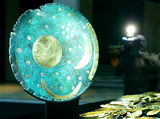
Taipei Times, Taiwan
|
|
According to Germany’s museum establishment, the Sky Disc of Nebra is the oldest depiction of the heavens discovered and offers an insight into the Bronze Age mind.
|
But the authenticity of the disc has been challenged by one of the country’s leading archaeologists, Peter Schauer of Regensburg University. He told a court in Halle that the artefact was nothing more than an amateurish forgery.
Prof Schauer said that the ancient-looking green patina on the artefact was not old at all, and had probably been artificially created in a workshop using acid, urine and a blowtorch.”
[Full Story]
“Ancient mound used in summer moon ritual”
January 27, 2005, Bangor Daily News, USA: “Sacred monuments. The ‘hippie’ revolution of the 1960s may have been predated by some 6,000 years if researchers’ suspicions about the chambered mound called Gavrinis are correct.
The mound, more than 26 feet high, is located on a small island off France’s Brittany coast and dates to 3500 B.C., making it older than the pyramids.
A passage into the mound extends for 40 feet before ending in a chamber. What immediately catches the eye are the walls that are covered with etchings of concentric rings, curves, chevrons, and serpentine wiggles.
They are reminiscent, says one archaeologist, of the ‘psychedelic art’ of the 1960s. They may have had the same inspiration, as well, since Neolithic pottery artifacts found in the chamber contain traces of cannabis.
The mound’s connection to the heavens was established when it was found that a line, running from the chamber to a stone at the entrance, points to the southernmost moonrise at ‘major standstill’. This means the full moon is at its highest point at midsummer and appears to temporarily halt before resuming its motions.
A white crystal rock was placed to catch the moon’s rays at this point and its white glow may have played a role in some mystical experience, particularly if it had some chemical help!”
[Full Story]
“Clues to lost star atlas found on Titans shoulder”
January 12, 2005, Earth Times, USA: “Carved in marble, Titan Atlas, kneeling on one knee is holding much more than a large marble globe on his shoulder. He is holding clues to the long-lost work of the ancient astronomer Hipparchus.
The statue known as the Farnese Atlas is a 7-foot tall marble work with a 65 cm in diameter globe on Titan’s one shoulder. What is more interesting than Titans well sculptured body is the globe that he carries.
It is this globe which accurately records positions of 41 constellations placed on a grid of reference circles, including the equator, tropics, colures, Arctic Circle, and Antarctic Circle. The locations of these constellations are now appearing to be based on the lost first star catalog made by Hipparchus around 129 BC.
Though the catalogue has been lost in the course of time there are many references made to it in works of other astronomer in past.
Scientists have now confirmed that the constellations on the globe are based on the lost catalogue of Hipparchus.”
[Full Story]
|
|
useful books from our
Astro-Archaeology
Bookshoppe
“A Little History of
Astro-Archaeology”
John F. Michell

EU English Edition
“Stonehenge today is a battlefield, not only for police and festivalgoers at midsummer but also for rival camps of archaeologists, astronomers, and other researchers into the mysteries of prehistoric religion and science. Controversy flared up in 1963, when Gerald Hawkins made early use of the computer to identify Stonehenge as an observatory for the sun and moon and an instrument for predicting eclipses. Further studies of megalithic sites by Alexander Thom proved that many of them were also related to the seasonal positions of the heavenly bodies.
The study of astro-archaeology has now expanded worldwide, bringing new revelations about the mystical sciences of antiquity. This “little history” summarizes the issues involved in astro-archaeology, and illustrates its principal sites and personalities. Included are recent findings of British scientists, whose records of anomalous levels of natural energies at stone circles are in accordance with the magical reputations of such places in local folklore.”
“Megaliths, Myths and Men:
An Introduction to
Astro-Archaeology”
Peter Lancaster Brown

EU English Edition
“Noted British astronomer’s fascinating study of early astronomical knowledge through the interpretation of Stonehenge, Carnac, other megalithic sites. Stone Age sculpture, astronomical computations, radiocarbon dating, many other topics. Over 140 maps, photos, illustrations. The author has very comprehensively analysed several sites and shown how they can be used as astronomical machines.
He discusses the different interpretations of the sites and includes many diagrams of sites including the important astronomical alignments. Very enjoyable overview of archaeo-astronomy. Brown neatly debunks the lunatic fringe, reveals some of the unsung heroes of the field, and provides a clear summary of current ideas for the lay person.”
“Stonehenge: A New Interpretation of Prehistoric Man and the Cosmos”
John David North

EU English Edition
“Argues that Stonehenge’s scientific purpose was to observe the setting midwinter sun, and that astronomical observations made by the ancient Britons were as rational and methodical as they are today. North brings his distinguished background in astronomy to this study of Neolithic monuments. His aim is ‘to discover certain patterns of intellectual and religious behavior through a study of archaeological remains that seem to have been deliberately directed in some way towards phenomena in the heavens.’
Most of this book is a painstakingly detailed on-site investigation. Judging from the scale of Stonehenge and other monuments that incorporated astronomical alignments, North argues that the heavens played a central place in Neolithic and Bronze Age religion.”
“Astronomy in Prehistoric
Britain and Ireland”
Clive Ruggles
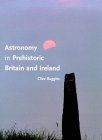
EU English Edition
“Do prehistoric stone monuments in Britain and Ireland incorporate deliberate astronomical alignments, and if so, what is their purpose and meaning? This work provides an account of megalithic astronomy debates and examines prehistoric man’s concern with celestial bodies and events. For decades debates have boiled among archaeologists and astronomers over the idea that prehistoric stone monuments in Britain deliberately incorporate astronomical alignments.
In this book Clive Ruggles is the first to approach the subject from the perspectives of both disciplines. He analyzes the history and lessons of previous debates, the most current research, and new agendas for future research.”
“Ancient Astronomers
(Exploring the Ancient World)”
Anthony F. Aveni
&
Jeremy A. Sabloff
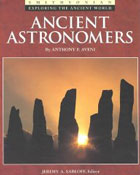
EU English Edition
“Anthony Aveni is well known in scholastic circles for his many excellent and ground-breaking publications in the field of archaeoastronomy. This particular volume is geared toward interested laymen and uninitiated scholars who are not yet well grounded in the history of astronomy or ideas of cosmology from an anthropological perspective. The book is graced with numerous and apt illustrations, while the text reads easily with Aveni’s smooth and informative style.
Chapters were clearly organized thoughtfully, as information builds upon previous explanations and new concepts or ideas are charted out for the neophytes as needed. “Ancient Astronomy” provides an ideal introduction to archaeoastronomy, ethnoastronomy, and cosmology for students in anthropology and the history of astronomy.”
“Prehistoric Astronomy
in the Southwest”
J. McKim Malville
&
Claudia Putnam
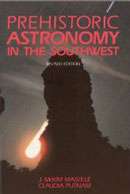
EU English Edition
“Archaeoastronomy is a discipline pioneered at Stonehenge and other megalithic sites in Britain and France. Many sites in the southwestern United States have yielded evidence of the prehistoric Anasazi’s intense interest in astronomy, similar to that of the megalithic cultures of Europe. The authors describe the astronomical alignments at the well-known sites of Chaco Canyon and Hovenweep and present new evidence, based on recent field work of alignments at Yellow Jacket, Chimney Rock, and Mesa Verde.
Drawing on the archaeological evidence, ethnographical parallels with historic pueblo peoples, and mythology from other cultures around the world, the authors present theories about the meaning and function of the mysterious stone alignments and architectural orientations of the prehistoric Southwest.”
“Stairways to the Stars: Skywatching in Three Great Ancient Cultures”
Anthony F. Aveni
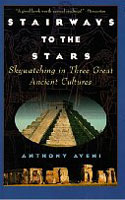
EU English Edition
“What is the meaning of Stonehenge? Why was the elaborate Incan city of Cuzco built? What is the significance of the Great Pyramid at the ancient Mayan city of Chichén Itz´? These ancient structures have spellbound natives and tourists alike. This mysterious architecture points to a centuries-old search for celestial order. Anthony Aveni, a professor of astronomy and anthropology, takes us on a stimulating virtual tour of these legendary constructions.
He describes how they were built and straightforwardly and often humorously critiques diverse theories attempting to explain their origin and function. For example, Aveni breathes life into the mysteries of the Great Pyramid and its use as a sacred temple, sacrificial altar, and celestial calendar.”
“Songs from the Sky: Indigenous Astronomical and Cosmological Traditions of the World”
V.D. Chamberlain (Editor)
J.B. Carlson (Editor)
M.J. Young (Editor)
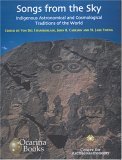
EU English Edition
“This substantial collection of papers on indigenous astronomical knowledge is quite unequalled in its scope and extent. The authors are drawn from a variety of academic disciplines, including anthropology, archaeology, astronomy, engineering, art history, history of science, history of religion, folklore, and mythology, and bring a variety of academic perspectives to bear upon aspects of celestial knowledge and perception in diverse social contexts from many different parts of the globe.
The Americas provide the main geographical focus, with twenty of the 32 papers concerning indigenous north American groups such as the Navajo, Lakota, Zuni and Blackfoot, the Mixe and Tzotzil Maya of southern Mexico, the Andean highlands and the Amazonian region of Peru, and southern coastal Brazil. The remaining twelve articles extend to the Arab world, sub-Saharan Africa, southern India, Java, Melanesia, Australia and Polynesia, with a few addressing broader synthetic themes. For a number of the culture areas dealt with in some detail here, other published information about sky knowledge is extremely scant.”
“East Asian Archaeoastronomy: Astronomical Observations of China, Japan and Korea”
Xu Zhentao, Jiang Yaotiao,
David W. Pankenier

EU English Edition
“Historical astronomical records can play an important role in modern research, especially in the case of ancient Chinese observational data: sunspot and aurora records are important for the study of solar variability; solar and lunar eclipse records for the study of the Earth’s rotation; records of Comet Hally for the study of orbital evolution; “guest star” records for the study of supernova remnants; planetary conjunction records for research in astronomical chronology.
In the past, Western scientists have not been able to exploit these valuable data fully because the original records were difficult to gather and interpret, and complete English translations have not been available. East-Asian Archaeoastronomy is the first comprehensive translation into English of such historical records for modern research.
The book also features an introduction to East Asian astronomy and offers guidance on how to use the records effectively. It will not only be a valuable research tool for astronomers but should also be of great interest to historians of China and Chinese science. Xu; Zhenoao Purple Mountin Observatory,Pankenier; W Department of Modern Foreign Language and Literatur,Yaotiao; Jiang Nanjing University , China.”
“Exploring Ancient Skies: An Encyclopedic Survey of Archaeoastronomy”
David Humiston Kelley
&
Eugene F. Milone
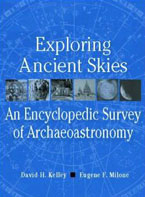
EU English Edition
“Exploring Ancient Skies brings together the methods of archaeology and the insights of modern astronomy to explore the science of astronomy as it was practiced in various cultures prior to the invention of the telescope. The book reviews an enormous and growing body of literature on the cultures of the ancient Mediterranean, the Far East, and the New World (particularly Mesoamerica), putting the ancient astronomical materials into their archaeological and cultural contexts.
The authors begin with an overview of the field and proceed to essential aspects of naked-eye astronomy, followed by an examination of specific cultures. The book concludes by taking into account the purposes of ancient astronomy: astrology, navigation, calendar regulation, and (not least) the understanding of our place and role in the universe.
Skies are recreated to display critical events as they would have appeared to ancient observers – events such as the supernova of 1054, the ‘lion horoscope’ or the ‘Star of Bethlehem.’Exploring Ancient Skies provides a comprehensive overview of the relationships between astronomy and other areas of human investigation. It will be useful as a reference for scholars and students in both astronomy and archaeology, and will be of compelling interest to readers who seek a broad understanding of our collective intellectual history.”
“Echoes of the Ancient Skies: The Astronomy of Lost Civilizations”
E.C. Krupp
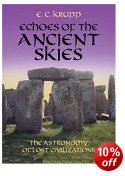
EU English Edition
“All over the world, through countless centuries, people have looked skyward for inspiration and guidance in their lives and activities. For most of the history of humankind, going back to the Stone Age, the sky has served as a tool. The regularity of the motions of celestial objects enabled our ancestors to orient themselves in time and space, satisfying their need for human order. How vast this heavenly influence was, and how awesome the human achievements it engendered were, are illuminated in this extraordinary work of investigation and discovery.
With hundreds of illustrations and photographs, Echoes of the Ancient Skies is a sweeping look at the world of archaeoastronomy from the prehistoric megaliths of Stonehenge, to the medicine wheels of North America, to the Aztec “Calendar Stone.”
The intriguing field of archaeoastronomy–the study of ancient peoples’ observation of the skies and its role in their cultural evolution–seeks to explore the “universal evidence that people have used astronomy as the model for injecting order and predictability on their behavior and on life.” Examining this universal behavior, Dr. E.C. Krupp takes the reader to sites throughout the world (most of which he has personally visited)–from Egypt, China, Babylonia, and Greece, to Turkey, Scotland, Wyoming, and Mexico. He interprets the significance of celestial observation and its relation to the earthly experiences of our ancestors, from practical applications of farming and the measurement of time to philosophical queries into our particular place within the universe.”
“The Stones of Time : Calendars, Sundials, and Stone Chambers
of Ancient Ireland”
Martin Brennan
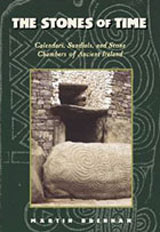
EU English Edition
“The Stones of Time presents one of the most dramatic archaeological detective stories of our time. Predating Stonehenge by at least a thousand years, the stone complexes of ancient Ireland have been extensively studied, yet have refused to give up their mystery. The most complete record of Irish megalithic art ever published.
Martin Brennan is a New York artist who spent three years of study on prehistoric art in Mexico and a similar period in Japan. Of Irish parentage, he was drawn to Ireland and the Boyne Valley, where he spent six years studying the neolithic stone chambers and their symbolic art before formulating the groundbreaking theories set forth in this book.”
“America’s Stonehenge:
The Mystery Hill Story”
David Goudsward
&
Robert E. Stone
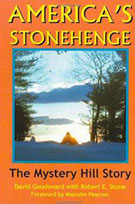
EU English Edition
“America’s Stonehenge sits atop Mystery Hill in North Salem, New Hampshire. It is an acre of stone structures surrounded by a 12-acre calendar. Alignments and carbon dating indicate the site was built 4000 years ago. In this book the authors explore the historical and prehistoric clues left behind at the archaeology site once described as a ‘mystery wrapped in an enigma’.
The history of the site is examined and traced from the clues left behind from visitors, residents and researchers, and how that has led to today’s research and the current interpretation of the evidence.”
“Skywatchers, Shamans and Kings: Astronomy and the
Archaeology of Power”
E.C. Krupp
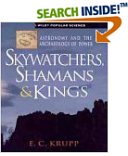
EU English Edition
“Discover the celestial myths and cosmic rituals of ancient priests and kings … Drawing on intimate knowledge of the more than 1,300 ancient sites he has visited, E. C. Krupp, acclaimed writer and preeminent researcher, takes you to the world’s essential sacred places and celestial shrines. Join him on a rich narrative journey to see where the rulers of old communed with the gods of the sky.
They ruled kingdoms and empires for thousands of years, tracing their lineages to gods in the sky and mastering the forces they believed moved the sun and moon, planets and stars. In an evocative, illustration-rich journey through lost civilizations, E. C. Krupp describes the workings of sky worship practiced by the pharaohs, emperors, lamas, and shamans of old.”
“In Search of Chaco:
New Approaches to an
Archaeological Enigma”
David Grant Noble
(Editor)
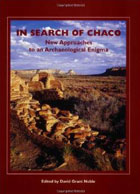
EU English Edition
“Startling discoveries and impassioned debates have emerged from the “Chaco Phenomenon” since the publication of New Light on Chaco Canyon twenty years ago. This completely updated edition features seventeen original essays, scores of photographs, maps, and site plans, and the perspectives of archaeologists, historians, and Native American thinkers.
Key topics include the rise of early greathouses; the structure of agricultural life among the people of Chaco Canyon; their use of sacred geography and astronomy in organizing their spiritual cosmology; indigenous knowledge about Chaco from the perspective of Hopi, Tewa, and Navajo peoples; and the place of Chaco in the wider world of archaeology.”
“Mysterious Britain”

VHS NTSC version
(USA and Canada)
VHS UK PAL version
(UK and Europe)
|